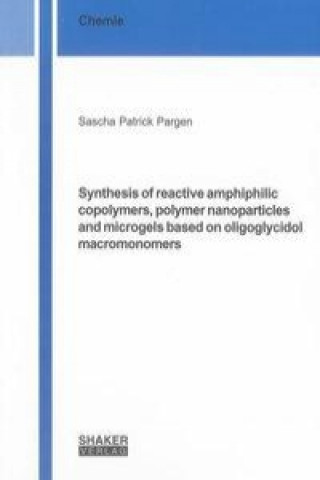
Code: 12709004
Synthesis of reactive amphiphilic copolymers, polymer nanoparticles and microgels based on oligoglycidol macromonomers
by Sascha Patrick Pargen
This thesis deals with the preparation of novel polymeric structures on the basis of hydroxy- functional prepolymers suitable for radical polymerization. These prepolymers, so called macromonomers, are versatile tools for introduc ... more
- Language:
 English
English - Binding: Paperback
- Number of pages: 170
Publisher: Shaker Verlag, 2013
- More about this

You might also like
-

Dune
35.33 zł -33 % -

Haunting Adeline
125.29 zł -2 % -

Berserk Deluxe Volume 2
214.34 zł -1 % -

White Nights
15.53 zł -23 % -

Powerless
44.77 zł -19 % -

Atomic Habits
80.31 zł -19 % -

Dune Messiah
46.70 zł -3 % -

Berserk Deluxe Volume 3
221.96 zł -

One Day
32.89 zł -36 % -

Berserk Deluxe Volume 1
213.53 zł -2 % -

Iron Flame
61.62 zł -28 % -

Surrounded by Idiots
51.57 zł -19 % -

Harry Potter and the Prisoner of Azkaban (Minalima Edition)
171.80 zł -2 % -

Gravity Falls Journal 3
89.75 zł -1 % -

Heaven Official's Blessing: Tian Guan Ci Fu (Novel) Vol. 1
89.75 zł -1 % -

The Creative Act
101.02 zł -15 % -

Dune
38.37 zł -38 % -

Hunting Adeline
131.18 zł -1 % -

A Little Life
48.93 zł -12 % -

Children of Dune
47.11 zł -2 % -

Heaven Official's Blessing: Tian Guan Ci Fu (Novel) Vol. 2
96.55 zł
Availability alert
Enter your e-mail address and once book will be available,
we will send you a message. It's that simple.
More about Synthesis of reactive amphiphilic copolymers, polymer nanoparticles and microgels based on oligoglycidol macromonomers
 Book synopsis
Book synopsis
This thesis deals with the preparation of novel polymeric structures on the basis of hydroxy- functional prepolymers suitable for radical polymerization. These prepolymers, so called macromonomers, are versatile tools for introducing hydrophilic moieties into polymer chains or for example can be used for stabilizing particles in aqueous solution. In this thesis, next to the synthesis of the macromonomers themselves, the preparation of amphiphilic copolymers, polymer nanoparticles and microgels based on hydrophilic macromonomers is presented. All macromonomers used in this thesis are based on polyglycidol, a polyether with similar structure to poly(ethylene oxide) but with a hydroxy methyl group in every repeating unit. The synthesis of the macromonomers was performed by anionic ring opening polymerization starting from allyl glycol, 4- vinyl benzyl alcohol (VBA) and N-hydroxyethyl methacryl amide (HEMAm). Thus, low molecular weight macromonomers with three to fifty repeating units were prepared. Branched oligoglycidol macromonomers were prepared by anionic polymerization of glycidol. Linear oligoglycidol macromonomers were synthesized using acetal protected glycidol (EEGE) followed by removal of the acetal protection group under acidic conditions. Successful copolymerization of these hydrophilic oligoglycidol macromonomers with hydrophobic monomers like styrene or different (meth)acrylates was performed using free radical polymerization. These reactions were a first step to show that copolymerization of the oligoglycidol macromonomers with different hydrophobic monomers is possible. For later applications it is important to prepare amphiphilic copolymers with defined structure and architecture. Therefore nitroxide mediated polymerization (NMP) was used to prepare amphiphilic block copolymers with defined block lengths. Next to the nitroxide TEMPO, suitable for controlled polymerization of styrene and derivates, the more universal NMP initiator combination SG1/ BlocBuilder was used for the copolymerization of VBA- and HEMAm- oligoglycidol macromonomers with different hydrophobic monomers. With a hydrophobic head group and a hydrophilic oligoglycidol chain VBA-oligoglycidol macromonomers are themselves amphiphilic. This fact was used in the synthesis of polystyrene nanoparticles via emulsion polymerization in water. The oligoglycidol macromonomers are water soluble and with their reactive double bond are able to bind covalently to the styrene core. Therefore the macromonomers act as a so called reactive surfactant, a surfmer. No other conventional surfactant had to be added. Linear and branched VBA- oligoglycidol macromonomers with variable oligoglycidol chain lengths were used. Monodisperse colloidally stable polystyrene particles decorated with oligoglycidol chains with diameters between 100 nm and 600 nm were obtained. These particles can be seen as substrates suitable for immobilization reactions or post polymerization reactions. The reactivity of the hydroxy groups on the particle surface was demonstrated by the successful chemical and enzyme catalyzed grafting polymerization of e-caprolactone yielding in the formation of composite particles. The concept of stabilizing particles in aqueous media was also transferred to the synthesis of poly(vinyl caprolactam) (PVCL) microgels. With the addition of oligoglycidol macromonomers uniform microgel particles were obtained. Furthermore the temperature-sensitive behavior of the microgel was improved. The usual aggregation of PVCL microgels in water at temperatures above 33°C was successful depressed by the stabilization with oligoglycidol macromonomers. Another approach for use of reactive surfactants in emulsion polymerization yielding functional particles was tested using a sugar functional acrylate. With the glucose acrylate monomer and the reactions procedure developed with the oligoglycidol macromonomers poly(methyl methacrylate) and polystyrene particles with monosaccharide enriched shell were obtained being an interesting tool for biomedical applications.
 Book details
Book details
- Full title: Synthesis of reactive amphiphilic copolymers, polymer nanoparticles and microgels based on oligoglycidol macromonomers
- Author: Sascha Patrick Pargen
- Language:
 English
English - Binding: Paperback
- Number of pages: 170
- EAN: 9783844017540
- ISBN: 3844017542
- ID: 12709004
- Publisher: Shaker Verlag
- Weight: 263 g
- Dimensions: 212 × 149 × 12 mm
- Date of publishing: March 2013
safisfied customers
Since 2008, we have served long line of book lovers, but each of them was always on the first place.
Copyright! ©2008-24 libristo.pl All rights reservedPrivacyPoučení o cookies



 21 million books
21 million books Delivery 12.99 zł
Delivery 12.99 zł (32) 444 93 66 (8-15.30h)
(32) 444 93 66 (8-15.30h)